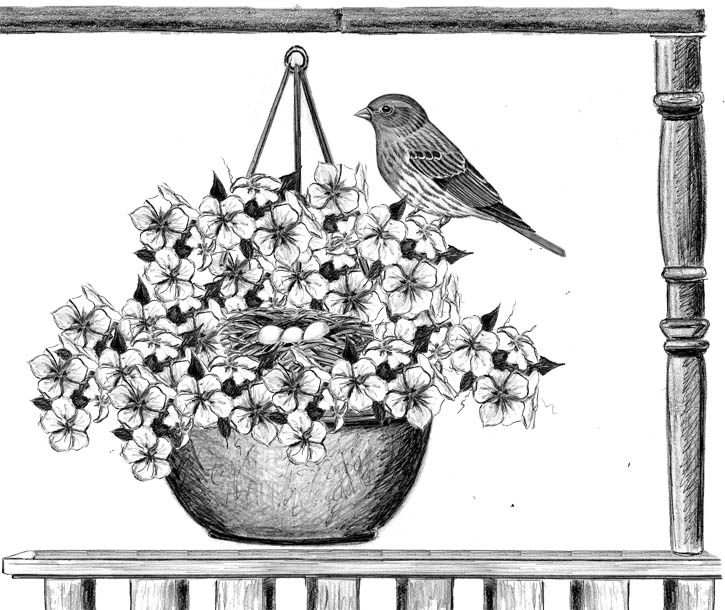
Dear Bird Folks,
I just discovered we have a House Finch nest in one of my hanging plants and now I’m afraid to water it for fear I’ll hurt the eggs. Should I run out and buy a birdhouse for them, and if I do, will they use it?
– Darlene, Falmouth, MA
Come on, Darlene,
This is a trick question, right? Asking a retailer if you should “run out and buy” something is like asking a dog if it wants to go for a walk, or asking a cat if it wants to take a nap. I think we all know what the answer is going to be. Yes, you should buy a birdhouse. Or, if you want to cut out the middleman, you could make one yourself. Several bird species, including chickadees, swallows and bluebirds, are likely to move in. Unfortunately, you won’t get any House Finches to use it. In spite of their name, House Finches don’t like houses, at least not birdhouses. Go figure.
The “house” in the House Finch’s name refers to human houses. These birds often nest around our homes, under our decks, on our porch lights, or, as you found out, in our hanging plants. Why do they choose these places? I think they want a roof over their heads, but would rather not jam into a tight bird box. (They must have some unresolved claustrophobia issues.) A planter hanging under a porch is prime real estate for a young finch couple looking to build their first starter nest. Offering them a new birdhouse, no matter how much you spend on it, isn’t going to convince them to move out of the planter. Speaking of how much you spend, I’m not a plant guy, but my wife is (well, not the “guy” part). She tells me that hanging plants and birdhouses cost roughly the same. So, instead of wishing the finches would move into your new birdhouse (which they won’t), my advice is to buy yourself a new hanging plant and let the birds stay in the old one.
That way, you get a new plant and the birds get to keep their home. Everyone wins. Well, everyone except me. I lose out on the sale of a birdhouse. Maybe I should start a flower department.
Should you continue to water the plant with the nest in it? Yes, you should. A healthy plant will grow more foliage, which help keep the nest and its contents well hidden from predators. I wouldn’t worry too much about getting the eggs wet. Bird eggs are made to be outside and thus are quite waterproof. The liquid from your watering can is no different than raindrops from a summer shower. Just don’t flood the plant. With the exception of Nautilus Ducks, bird eggs don’t do well under water.
I’ve written about House Finch expansion before, but in case you weren’t paying attention, I’ll do it again. House Finches are native to the western half of North America. In 1939, some boneheads captured a flock of finches, took them to NYC and attempted to sell them as “Hollywood Finches.” This, of course, is illegal and eventually the Feds got wind of the scam. But before the bad guys could be caught with the goods, they (the bad guys) opened the window, let the evidence fly away and that was the end of that. Well, not exactly. Instead of heading back home, the escaped birds stayed here, had families and quickly colonized the entire East Coast. Today the population of House Finches is estimated to be as high as 1.4 billion birds…and most of them seem to be at my house.
Discovering a House Finch nest in a hanging plant may be annoying to some, but I think most folks get a kick out of it. And like I said earlier, there is no reason to stop caring for your plant. Just take it off the hook and carefully water around the nest. Some folks cringe when I tell them it’s okay to handle the planter, but these people probably still believe the silly notion that the parent birds can “smell” us. That old wives tale is right up there with toads causing warts and eating before swimming can make you go blind (or something like that). Enjoy your finches and your plant, Darlene. I think with a little care both will be just fine. If you want, you could even take a quick photo of the chicks and I don’t think they’d mind. After all, they are Hollywood Finches and getting photographed is in their blood.
On a different topic:
For the past few weeks we have been plagued by reports of missing suet feeders, damaged seed feeders and hummingbird feeders that are completely empty in the morning. As usual, most people point their finger at my buddies, the gray squirrels, or think their hummingbird feeder is leaking. Wrong and wrong. Somehow, folks have forgotten about the late night work of raccoons. Under the cover of darkness, raccoons habitually steal suet feeders, trash seed feeders and guzzle hummingbird nectar. What can you do about it? You can put up a pole that is protected by a raccoon baffle, but that can be pricey. The cheapest thing to do is set your alarm for just before dark. When the alarm goes off, stop what you are doing, walk outside and take your feeders in the house. I know doing this can be a lot of work, but at least your feeders will be around to feed another day. Or, you could simply buy new feeders each time the raccoons steal or trash them. I’m okay with that, too.